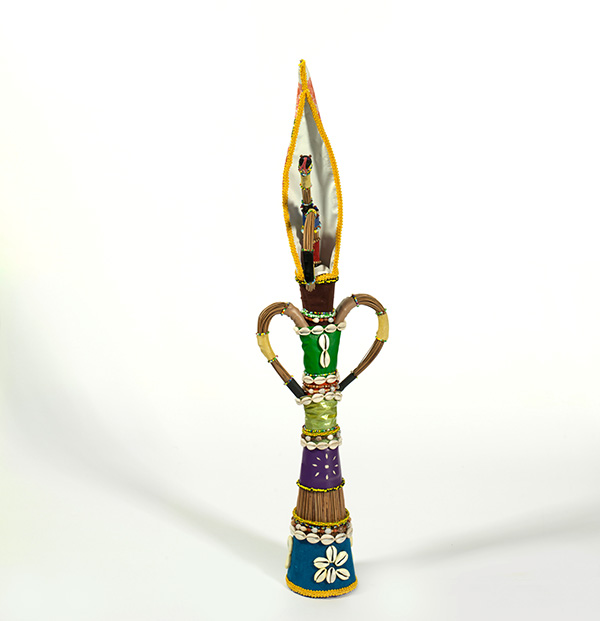Audio Stop 961

painted leather, fabric, shells and beads on palm tree vein
Museu de Arte de São Paulo Assis Chateaubriand, Gift of Ana Dale, Carlos Dale Junior, Antonio Almeida, Thais Darzé, and Paulo Darzé, in the context of the Afro-Atlantic Histories exhibition, 2018
Mestre Didi (Deoscóredes Maximiliano dos Santos)
Sasara Ati Aso Ailo, 1960, Ope Olodo Ejo—River Serpent Palm, undated
Read full audio transcript
STEVEN NELSON:
We’re looking at two works by Mestre Didi.
NARRATOR:
Steven Nelson, co-curator of the exhibition.
STEVEN NELSON:
They’re made with a combination of materials of palm tree veins or of raffia, leather, shells and beads. Although we think of them as sculpture, they’re the meeting of religious objects and fine art.
Taken as a whole, they symbolize the deity Oshunmare, who was the Candomblé deity of the rainbow. And so if you look, the leather in these pieces are dyed. They’re blue, red, black, yellow, purple. You know, the colors of the rainbow. And the shells and the beads suggest wealth. They also suggest a kind of opulence. The raffia suggests ancestry and continuity.
NARRATOR:
Ana Lucia Araujo is professor of history at Howard University.
ANA LUCIA ARAUJO:
Candomblé is an Afro-Brazilian religion that has elements that were brought by enslaved people from different parts of West Africa and West Central Africa. It's a religion that is based on dance, music, spirit possession as well. And, Mestre Didi was a descendant of a family, indeed of priests or individuals who had an important role on these temples.
NARRATOR:
The significance of sculptures and the items used to create them is informed by the context of the Atlantic slave trade.
ANA LUCIA ARAUJO:
For example, the use of cowrie shells, in these different sculptures. Cowrie shells were currencies during the period of the Atlantic slave trade, then, human beings were purchased with cowrie shells. And, then we see these connections with the African continent through these small things that were reconfigured once they are brought to a place like Brazil to be featured then in these temples, and then in these objects as well. And then they become artworks, as you are seeing here.